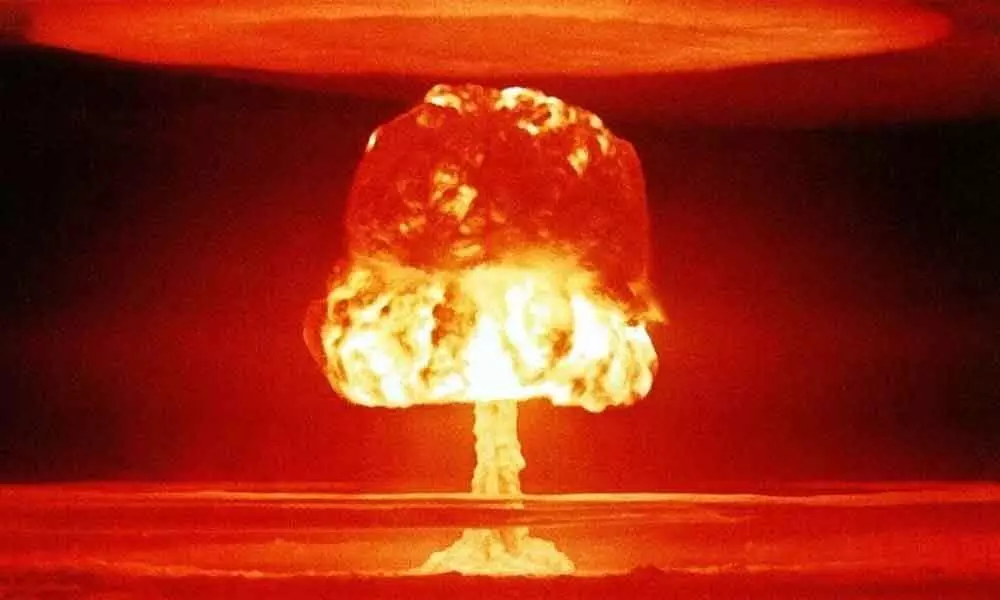Live
- A treasure trove of stories to come alive at Hawa Mahal
- Sports meet for police personnel commences
- Three persons admitted to hospital for diarrhea treatment
- First Star Outside Milky Way Captured: WOH G64 is 2,000 Times Larger Than the Sun
- Sikkim govt to constitute state Niti Ayog: CM Tamang
- CBI books Rajasthan narcotics inspector for Rs 3 lakh bribe
- Rajasthan bypolls: A tough contest between BJP and Congress
- Albania joins SEPA, paving way for EU integration
- Japanese government approves 250-billion USD economic package to ease price pain
- Six pharma companies to set up their units in Telangana
Just In

If Pakistan Prime Minister Imran Khan's repeated forecast of a nuclear war between India and Pakistan comes true, anywhere between 5 crore to 12.5 crore people will die within a span of less than a week -- more than the death toll during all six years of World War II, according to new research.
New Delhi : If Pakistan Prime Minister Imran Khan's repeated forecast of a nuclear war between India and Pakistan comes true, anywhere between 5 crore to 12.5 crore people will die within a span of less than a week -- more than the death toll during all six years of World War II, according to new research.
Today, India and Pakistan each have about 150 nuclear warheads at their disposal and that number is expected to climb to more than 200 by 2025.
The study conducted by researchers from the University of Colorado Boulder and Rutgers University in the US examined how such a hypothetical future conflict would have consequences that could ripple across the globe.
The researchers calculated that an India-Pakistan war could inject as much as 80 billion pounds of thick, black smoke into Earth's atmosphere.
"The picture is grim. That level of warfare wouldn't just kill millions of people locally," said Brian Toon from CU Boulder, who led the research published in the journal Science Advances.
"Hopefully, Pakistan and India will take note of this paper. But mostly, I'm concerned that Americans aren't informed about the consequences of nuclear war," the researchers noted.
The scenario might also plunge the entire planet into a severe cold spell, possibly with temperatures not seen since the last Ice Age.
"An India-Pakistan war could double the normal death rate in the world," said Toon, a professor in the Laboratory of Atmospheric and Space Physics. "This is a war that would have no precedent in human experience".
Toon believes that such weapons are still very much a threat -- one that's underscored by current hostilities between India and Pakistan.
"They're rapidly building up their arsenals," Toon said.
"They have huge populations, so lots of people are threatened by these arsenals, and then there's the unresolved conflict over Kashmir."
In the latest study, Toon and his colleagues wanted to find out just how bad such a conflict could get.
To do that, the team drew on a wide range of evidence, from computer simulations of Earth's atmosphere to accounts of the bombings of Hiroshima and Nagasaki in Japan in 1945. Based on their analysis, the devastation would come in several stages.
In the first week of the conflict, the group reports that India and Pakistan combined could successfully detonate about 250 nuclear warheads over each other's cities.
There's no way to know how powerful these weapons would be--neither nation has conducted nuclear tests in decades--but the researchers estimated that each one could kill as many as 700,000 people. Most of those people wouldn't die from the blasts themselves, however, but from the out-of-control fires that would follow.
"If you look at Hiroshima after the bomb fell, you can see a huge field of rubble about a mile wide," Toon said. "It wasn't the result of the bomb. It was the result of the fire."
For the rest of the globe, the fires would just be the beginning.
The black smoke would block sunlight from reaching the ground, driving temperatures around the world down for several years. Worldwide food shortages would likely come soon after.
"Our experiment, conducted with a state-of-the-art Earth system model, reveals large-scale reductions in the productivity of plants on land and of algae in the ocean, with dangerous consequences for organisms higher on the food chain, including humans," said study coauthor Nicole Lovenduski, an associate professor of atmospheric and oceanic sciences and a fellow of the Institute of Arctic and Alpine Research (INSTAAR).

© 2024 Hyderabad Media House Limited/The Hans India. All rights reserved. Powered by hocalwire.com







